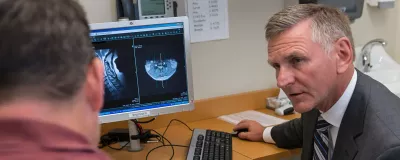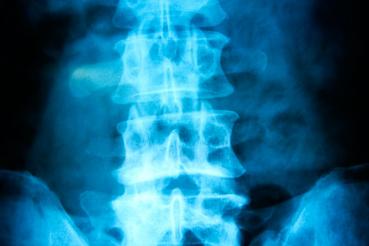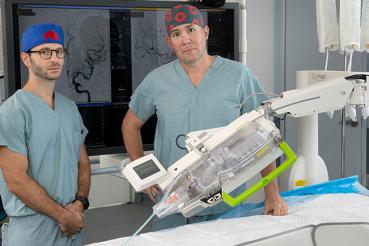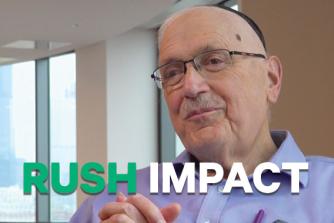The Rush Approach to Neurosurgery
When an illness or injury affects your brain, spine or nerves, you may have symptoms ranging from pain or weakness to seizures or memory problems.
Sometimes you can manage these symptoms with medicine or other nonsurgical therapies. But in other cases, your best (or only) treatment option might be surgery.
Rush neurosurgeons provide planned and emergency treatments for even the most rare or complex conditions. Our areas of expertise include:
- Brain surgery: We can remove a brain tumor, treat epilepsy or control tremors caused by movement disorders.
- Cerebrovascular surgery: We treat brain aneurysms, stroke and other blood vessel problems in and around your brain.
- Skull base surgery: We offer complex procedures to remove acoustic neuromas, pituitary adenomas and other tumors that grow in the base of your skull.
- Spine surgery: We treat spinal tumors, spinal cord injuries and all forms of degenerative disc disease.
Whenever possible, our neurosurgeons use minimally invasive approaches that may help you leave the hospital sooner and recover more quickly.
Brain Conditions Treated
-
Acoustic Neuroma (Vestibular Schwannoma)
-
Arteriovenous Malformation (AVM)
-
Basilar Skull Fracture
-
Carotid Artery Stenosis
-
Cavernous Malformation
-
Cerebral Hemorrhage
-
Cerebrospinal Fluid (CSF) Leak
-
Cerebrovascular Disease
-
Cholesterol Granuloma
-
Chondroma
-
Chondrosarcoma
-
Cranial Base Tumors
-
Craniopharyngioma
-
Cryptogenic Stroke
-
Dural Arteriovenous Fistula
-
Ear Cancer
-
-
Essential Tremor
-
Eye Cancer
-
Glioma
-
Hemangioma
-
Hemifacial Spasms
-
Hemorrhagic Stroke
-
Hydrocephalus
-
Intracranial Atherosclerosis
-
Intracranial Stenosis
-
Ischemic Stroke
-
Moyamoya Disease
-
Nasal Cavity Cancer
-
Neurofibromatosis Type 1 (NF1)
-
Orbital Tumors
-
Osteomyelitis
-
Paraganglioma
-
Paranasal Sinus Cancer
-
Rathke’s Cleft Cyst
-
Sinus Cancer
-
Sinus Tumor
-
Subarachnoid Hemorrhage
-
Transient Ischemic Attack (TIA)
-
Tremor
-
Acoustic Neuroma (Vestibular Schwannoma)
-
Arteriovenous Malformation (AVM)
-
Basilar Skull Fracture
-
Carotid Artery Stenosis
-
Cavernous Malformation
-
Cerebral Hemorrhage
-
Cerebrospinal Fluid (CSF) Leak
-
Cerebrovascular Disease
-
Cholesterol Granuloma
-
Chondroma
-
Chondrosarcoma
-
Cranial Base Tumors
-
Craniopharyngioma
-
Cryptogenic Stroke
-
Dural Arteriovenous Fistula
-
Ear Cancer
-
-
Essential Tremor
-
Eye Cancer
-
Glioma
-
Hemangioma
-
Hemifacial Spasms
-
Hemorrhagic Stroke
-
Hydrocephalus
-
Intracranial Atherosclerosis
-
Intracranial Stenosis
-
Ischemic Stroke
-
Moyamoya Disease
-
Nasal Cavity Cancer
-
Neurofibromatosis Type 1 (NF1)
-
Orbital Tumors
-
Osteomyelitis
-
Paraganglioma
-
Paranasal Sinus Cancer
-
Rathke’s Cleft Cyst
-
Sinus Cancer
-
Sinus Tumor
-
Subarachnoid Hemorrhage
-
Transient Ischemic Attack (TIA)
-
Tremor
-
Acoustic Neuroma (Vestibular Schwannoma)
-
Arteriovenous Malformation (AVM)
-
Basilar Skull Fracture
-
Carotid Artery Stenosis
-
Cavernous Malformation
-
Cerebral Hemorrhage
-
Cerebrospinal Fluid (CSF) Leak
-
Cerebrovascular Disease
-
Cholesterol Granuloma
-
Chondroma
-
Chondrosarcoma
-
Cranial Base Tumors
-
Craniopharyngioma
-
Cryptogenic Stroke
-
Dural Arteriovenous Fistula
-
Ear Cancer
-
-
Essential Tremor
-
Eye Cancer
-
Glioma
-
Hemangioma
-
Hemifacial Spasms
-
Hemorrhagic Stroke
-
Hydrocephalus
-
Intracranial Atherosclerosis
-
Intracranial Stenosis
-
Ischemic Stroke
-
Moyamoya Disease
-
Nasal Cavity Cancer
-
Neurofibromatosis Type 1 (NF1)
-
Orbital Tumors
-
Osteomyelitis
-
Paraganglioma
-
Paranasal Sinus Cancer
-
Rathke’s Cleft Cyst
-
Sinus Cancer
-
Sinus Tumor
-
Subarachnoid Hemorrhage
-
Transient Ischemic Attack (TIA)
-
Tremor
Spine Conditions Treated
-
Ankylosing Spondylitis
-
Back Pain
-
Cavernous Malformation
-
Cervical Myelopathy
-
Cervical Radiculopathy
-
Chondrosarcoma
-
Diffuse Idiopathic Skeletal Hypertrophy (DISH)
-
Failed Back Surgery Syndrome
-
Flat-back Syndrome
-
Giant Cell Tumor
-
Hemangioblastoma
-
Lumbar Stenosis
-
Myelopathy
-
Neck Pain
-
Osteoporosis of the Spine
-
Radiculopathy
-
Rheumatoid Arthritis
-
Sacroiliac (SI) Joint Pain
-
Scheuermann's Kyphosis
-
Schwannoma
-
Spinal Cord Injury
-
Spinal Fractures
-
Spinal Infection
-
Spinal Kyphosis
-
Spinal Metastatic Tumors
-
Spinal Tumor
-
Spondylolisthesis
-
Spondylolysis
-
Thoracic Stenosis
-
Ankylosing Spondylitis
-
Back Pain
-
Cavernous Malformation
-
Cervical Myelopathy
-
Cervical Radiculopathy
-
Chondrosarcoma
-
Diffuse Idiopathic Skeletal Hypertrophy (DISH)
-
Failed Back Surgery Syndrome
-
Flat-back Syndrome
-
Giant Cell Tumor
-
Hemangioblastoma
-
Lumbar Stenosis
-
Myelopathy
-
Neck Pain
-
Osteoporosis of the Spine
-
Radiculopathy
-
Rheumatoid Arthritis
-
Sacroiliac (SI) Joint Pain
-
Scheuermann's Kyphosis
-
Schwannoma
-
Spinal Cord Injury
-
Spinal Fractures
-
Spinal Infection
-
Spinal Kyphosis
-
Spinal Metastatic Tumors
-
Spinal Tumor
-
Spondylolisthesis
-
Spondylolysis
-
Thoracic Stenosis
-
Ankylosing Spondylitis
-
Back Pain
-
Cavernous Malformation
-
Cervical Myelopathy
-
Cervical Radiculopathy
-
Chondrosarcoma
-
Diffuse Idiopathic Skeletal Hypertrophy (DISH)
-
Failed Back Surgery Syndrome
-
Flat-back Syndrome
-
Giant Cell Tumor
-
Hemangioblastoma
-
Lumbar Stenosis
-
Myelopathy
-
Neck Pain
-
Osteoporosis of the Spine
-
Radiculopathy
-
Rheumatoid Arthritis
-
Sacroiliac (SI) Joint Pain
-
Scheuermann's Kyphosis
-
Schwannoma
-
Spinal Cord Injury
-
Spinal Fractures
-
Spinal Infection
-
Spinal Kyphosis
-
Spinal Metastatic Tumors
-
Spinal Tumor
-
Spondylolisthesis
-
Spondylolysis
-
Thoracic Stenosis
Neurosurgery Tests and Treatments
-
3d Printing
-
Aneurysm Clipping
-
Angiogram
-
Anterior Cervical Discectomy and Fusion (ACDF)
-
Anterior Lumbar Interbody Fusion (ALIF)
-
Baclofen Pump
-
Carotid Endarterectomy
-
Carotid Ultrasound
-
Craniotomy
-
CT Scan
-
Discectomy
-
Dynamic Stabilization
-
Embolization
-
Endoscopic Orbital Decompression
-
Endoscopic Sinus Surgery
-
Endoscopic Transnasal, Transsphenoidal Pituitary Surgery
-
Focal Resection
-
Foraminotomy
-
Laminectomy
-
Low-Dose Imaging (EOS Imaging)
-
Mechanical Thrombectomy
-
Microdiscectomy
-
Microvascular Decompression
-
Minimally Invasive Spine Surgery
-
Nerve Decompression
-
Patient-specific Implants
-
Responsive Neurostimulation (RNS)
-
Sacroiliac (SI) Joint Fusion
-
Scoliosis Surgery
-
Single Photon Emission Computed Tomography (SPECT Scan)
-
SISCOM
-
Spinal Decompression
-
Spinal Fusion
-
Spinal Navigation
-
Spinal Robotics
-
Spinal Stimulator
-
Stent Placement
-
Stereotactic Radiosurgery (SRS)
-
Tear Duct Surgery (Endoscopic Dacryocystorhinostomy)
-
Temporal Lobectomy
-
Thrombolysis
-
Transforaminal Lumbar Interbody Fusion (TLIF)
-
Vagus Nerve Stimulation
-
Virtual-reality Spine Surgery
-
3d Printing
-
Aneurysm Clipping
-
Angiogram
-
Anterior Cervical Discectomy and Fusion (ACDF)
-
Anterior Lumbar Interbody Fusion (ALIF)
-
Baclofen Pump
-
Carotid Endarterectomy
-
Carotid Ultrasound
-
Craniotomy
-
CT Scan
-
Discectomy
-
Dynamic Stabilization
-
Embolization
-
Endoscopic Orbital Decompression
-
Endoscopic Sinus Surgery
-
Endoscopic Transnasal, Transsphenoidal Pituitary Surgery
-
Focal Resection
-
Foraminotomy
-
Laminectomy
-
Low-Dose Imaging (EOS Imaging)
-
Mechanical Thrombectomy
-
Microdiscectomy
-
Microvascular Decompression
-
Minimally Invasive Spine Surgery
-
Nerve Decompression
-
Patient-specific Implants
-
Responsive Neurostimulation (RNS)
-
Sacroiliac (SI) Joint Fusion
-
Scoliosis Surgery
-
Single Photon Emission Computed Tomography (SPECT Scan)
-
SISCOM
-
Spinal Decompression
-
Spinal Fusion
-
Spinal Navigation
-
Spinal Robotics
-
Spinal Stimulator
-
Stent Placement
-
Stereotactic Radiosurgery (SRS)
-
Tear Duct Surgery (Endoscopic Dacryocystorhinostomy)
-
Temporal Lobectomy
-
Thrombolysis
-
Transforaminal Lumbar Interbody Fusion (TLIF)
-
Vagus Nerve Stimulation
-
Virtual-reality Spine Surgery
-
3d Printing
-
Aneurysm Clipping
-
Angiogram
-
Anterior Cervical Discectomy and Fusion (ACDF)
-
Anterior Lumbar Interbody Fusion (ALIF)
-
Baclofen Pump
-
Carotid Endarterectomy
-
Carotid Ultrasound
-
Craniotomy
-
CT Scan
-
Discectomy
-
Dynamic Stabilization
-
Embolization
-
Endoscopic Orbital Decompression
-
Endoscopic Sinus Surgery
-
Endoscopic Transnasal, Transsphenoidal Pituitary Surgery
-
Focal Resection
-
Foraminotomy
-
Laminectomy
-
Low-Dose Imaging (EOS Imaging)
-
Mechanical Thrombectomy
-
Microdiscectomy
-
Microvascular Decompression
-
Minimally Invasive Spine Surgery
-
Nerve Decompression
-
Patient-specific Implants
-
Responsive Neurostimulation (RNS)
-
Sacroiliac (SI) Joint Fusion
-
Scoliosis Surgery
-
Single Photon Emission Computed Tomography (SPECT Scan)
-
SISCOM
-
Spinal Decompression
-
Spinal Fusion
-
Spinal Navigation
-
Spinal Robotics
-
Spinal Stimulator
-
Stent Placement
-
Stereotactic Radiosurgery (SRS)
-
Tear Duct Surgery (Endoscopic Dacryocystorhinostomy)
-
Temporal Lobectomy
-
Thrombolysis
-
Transforaminal Lumbar Interbody Fusion (TLIF)
-
Vagus Nerve Stimulation
-
Virtual-reality Spine Surgery
Neurosurgery Providers at Rush
Rush has neurosurgery providers in downtown Chicago, the western suburbs and Aurora/Fox Valley.
 Meet our neurosurgery providers
Meet our neurosurgery providers
Rush Excellence in Neurosurgery
- Prompt access to care: For many patients, a key step in determining eligibility for surgery is a brain or spine imaging test. Our neurosurgeons review most imaging test results within 24 hours. This lets us quickly confirm whether you’d benefit from surgery, so we can schedule your procedure as soon as possible.
- The latest surgical treatments for movement disorders: We offer one of the newest approved treatments for essential tremor and Parkinson’s disease: focused ultrasound. With focused ultrasound, or FUS, we use sound waves to damage any brain tissue that causes tremors. We also have a long history of treating certain movement disorders with deep brain stimulation (DBS).
- Sophisticated spine surgery: Our spine surgeons have a breadth of experience and depth of expertise that’s hard to find. We also offer innovative spine surgery procedures that are not widely available, including robotic and endoscopic spine surgery. We use these procedures to remove complex spinal tumors and treat degenerative conditions like herniated discs, spinal stenosis, spondylolisthesis and scoliosis.
- The full range of epilepsy surgery options: We offer every approved surgical procedure for people who can’t control their epilepsy with anti-seizure medication. These include vagus nerve stimulation, DBS and laser interstitial therapy (LITT).
- Highly specialized, team-based care: Many of our neurosurgeons are subspecialists, meaning they have advanced training (and extensive experience) in specific conditions and procedures. These same neurosurgeons often partner with other Rush subspecialists, such as neurologists, head and neck surgeons, and facial plastic and reconstruction experts. Together, we provide a level of expertise — and a range of services — that aren’t available at every medical center.
Among the Best in the U.S.

U.S. News & World Report ranked Rush University Medical Center among the best in the nation for neurology and neurosurgery care.





